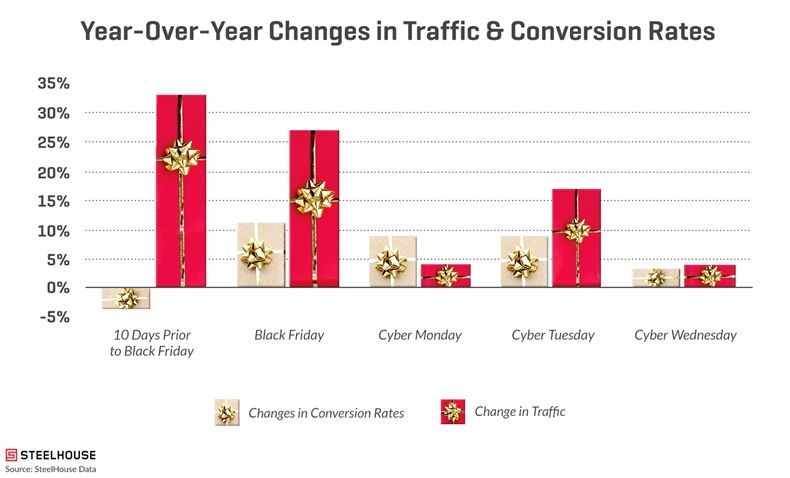Shoppers are nuts for Black Friday and Cyber Monday. In fact, their excitement is spilling over into the rest of the week and leading them to buy everything on their shopping lists—gift or not.
That’s because shoppers have realized that this time of year is the best time to get a deal on practically anything. And retailers don’t let them down: Brick-and-mortar and e-commerce brands alike run their best deals of the year during Black Friday and Cyber Monday. That has convinced many shoppers that they should buy not only their holiday gifts during this stretch of time but also any other items on their to-do list.
The key to success this holiday season is discovering how to take advantage of this and other emerging trends. To that end, SteelHouse analyzed thousands of retargeting, branding, and prospecting campaigns across display, mobile, social, and Connected TV (CTV) that ran across the SteelHouse network last year. The collected learnings are summarized in the SteelHouse Holiday Guide to help marketers get the most out of the season.
Here’s a quick rundown of some of the study findings, and ways you can leverage them for holiday success.
1. Once Black Friday hits, shoppers spend well into Cyber Week

SteelHouse data from the 2018 holiday shopping season suggests that once Black Friday gets closer on the calendar, shoppers wait to convert. In the 10 days preceding Black Friday, site traffic soared as shoppers researched potential purchases, whereas conversions dropped in anticipation of better deals just days away. Once Black Friday hit, both site traffic and conversions surged, and continued to do so well into Cyber Week.
For any marketer looking to take full advantage of this major shopping period, it’s a good idea to keep your budget prepared to engage users over Thanksgiving weekend as well as into Cyber Week. Shoppers are deal-hungry; and, as the data suggests, many who are active on Black Friday and Cyber Monday will continue to shop days after. Shoppers now see the period from Black Friday to the end of Cyber Week as one major shopping event… and you should, too.
2. Connected TV is an effective performance channel

Over 190 million Americans watch CTV. This holiday season, advertisers need to take advantage of that fact. Based on Q4 2018 SteelHouse campaign data, CTV paired with audience-extension ads (display ads served to viewers who saw the CTV ad) were more effective at driving site visits than social and display prospecting campaigns.
And not only that: CTV holiday campaigns averaged a 6X return on ad spend, proving they too are effective at driving conversions.
Any advertiser with existing video assets—whether intended for traditional TV, YouTube, or social—should strongly consider leveraging those assets on Connected TV as well. CTV ads are unskippable and they reach users as they settle in to stream TV in the comfort of their living rooms.
According to the Video Advertising Bureau, ads shown on TV screens generate 32% more ad recall than the next closest device. Advertisers would do well to take advantage of that fact this holiday season—and start driving site traffic and conversions with Connected TV.
3. Prospecting and retargeting are better together

Based on SteelHouse data, brands that ran prospecting campaigns as well as retargeting reaped significant benefits. Which makes sense: lower-funnel efforts are more effective when they have a large targeting pool to choose from. By launching prospecting campaigns early in the holiday season, you can drive more site traffic, increase your retargeting pool, and then drive more conversions as you bring those users further down the funnel. Brands that ran prospecting and retargeting drove far more conversions than those that ran retargeting alone, our data shows.
There were stark increases in conversion rates in November and December for advertisers that ran prospecting throughout the quarter. In fact, the increase in conversions were almost in direct correlation to the increase in their average spend, showing that advertisers can get a solid return on their upper-funnel efforts.
Prospecting campaigns launched earlier in the season can reap major benefits for your lower-funnel efforts, so make sure you have your budget ready for them.
4. Gifts or not, shoppers are buying everything on their list
Black Friday, Cyber Monday, and Cyber Week are the best time of year to get a deal—period. And shoppers know it, which means they’re looking to spend not only on gifts but on everything else on their list as well. Retailers and e-commerce brands that are not traditionally known as gift-giving destinations can benefit by running sales during the frenzy of the major shopping holidays this year.
The key to success for nongift brands is awareness. Advertisers that fall into this category should plan to have deals ready for Black Friday and Cyber Monday, then set out to raise awareness of their brand and holiday promos. From October to November, launch multiple campaigns across display, social, Connected TV, and email to educate shoppers of upcoming deals.
Your biggest potential obstacle is your audience’s not knowing that you’re offering savings. Once that hurdle has been cleared, you’re in a good position to reap the rewards.
Build a holiday strategy that captures shoppers
Whether they’re shopping from the comfort of their own homes or lining up around a brick-and-mortar retailer on a cold morning, holiday shoppers are ready to spend. If you’re looking for better ways to engage your audience and drive conversions, download the SteelHouse Holiday Guide. It’s full of stats, trends, and insights that you can leverage to ensure you get the most out of your advertising efforts this holiday season.
